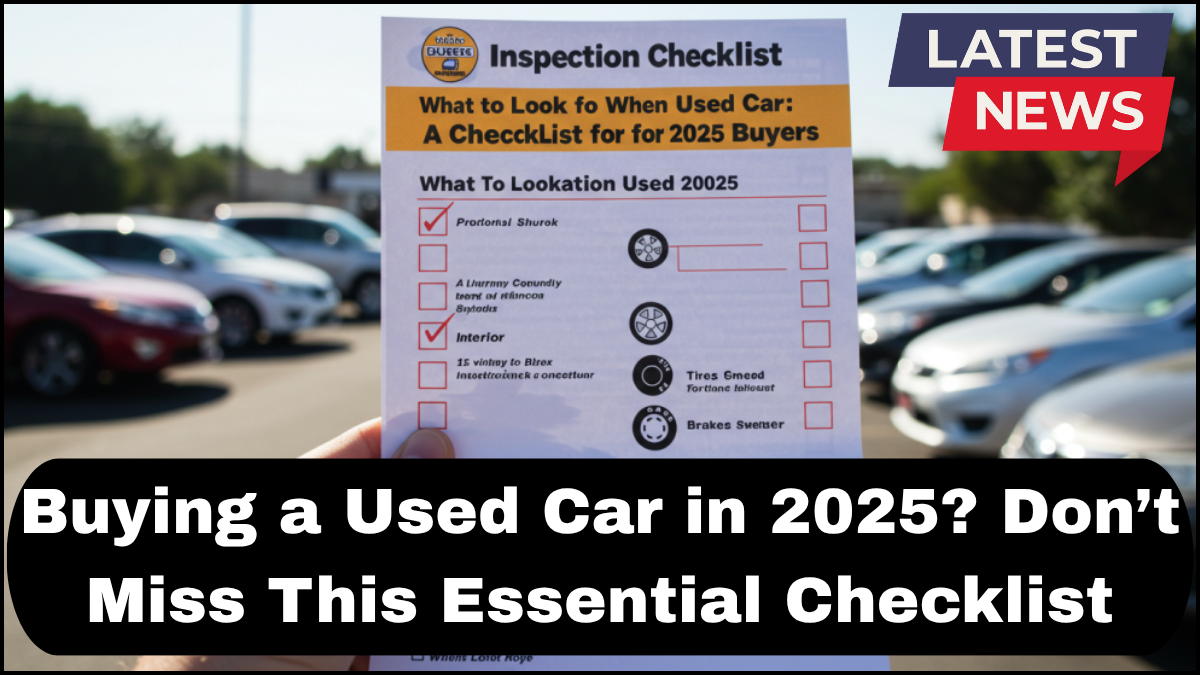Shopping for a used car in 2025 can be a smart financial move—if you do it right. With rising prices on new vehicles, the pre-owned market is more attractive than ever. But this surge in demand also means you have to be extra vigilant. Whether you’re a seasoned buyer or it’s your first time stepping into the world of pre-owned vehicles, this guide outlines an essential checklist to ensure you drive away with confidence—not regret.

Below, we break down what you need to know, what to check, and what red flags to watch out for.
Do Your Homework First
Before you even step onto a lot or browse online listings, get clear about your needs and budget. This saves time and helps avoid emotional purchases.
-
Set a realistic budget. Consider not just the purchase price, but also insurance, taxes, registration, and potential repairs.
-
Research models. Focus on reliability, fuel efficiency, and common maintenance issues. Consumer Reports, Edmunds, and Kelley Blue Book are reliable sources.
-
Compare prices. Use tools like Carfax, Autotrader, or CarGurus to see what similar models are selling for in your area.
Used car tips for first-time buyers: Stick to models with solid reputations for durability and low ownership costs. Avoid luxury vehicles unless you’re ready for expensive repairs.
Inspect the Exterior and Interior Carefully
A car’s appearance can reveal more than just cosmetic issues—it can hint at neglect or previous damage.
-
Check for rust, dents, or mismatched paint. These may indicate previous accidents.
-
Inspect tire wear. Uneven wear could signal alignment issues or suspension problems.
-
Test all electronics. Power windows, lights, infotainment systems, and air conditioning should all function properly.
Pay special attention to the interior odor. A musty smell may suggest water damage, which can lead to electrical problems down the road.
Dive into the Mechanics (Even If You’re Not a Mechanic)
Unless you’re a professional, bring a trusted mechanic to inspect the vehicle before purchase. If the seller resists, walk away.
-
Check under the hood. Look for leaks, corrosion, or cracked belts and hoses.
-
Test drive thoroughly. Drive on local streets and highways. Listen for strange noises, test the brakes, and observe how the transmission shifts.
-
Look for warning lights. If the check engine light is on, get a diagnostic scan.
Pre-owned vehicle checklist must-have: Ask for maintenance records. A car with regular oil changes and services is more likely to be reliable.
Verify the Vehicle History Report
This is where many buyers make a critical mistake: skipping the background check.
-
Get a vehicle history report from services like Carfax or AutoCheck. It should include title status, accident history, ownership records, and more.
-
Confirm the VIN (Vehicle Identification Number) on the car matches the documents.
-
Check for recalls on the make and model. You can do this for free at the National Highway Traffic Safety Administration (NHTSA) website.
Ask the Right Questions
Don’t hesitate to ask the seller pointed, specific questions:
-
Why are you selling the car?
-
Has it been in any accidents?
-
When was the last service done?
-
Are you the original owner?
The way they answer can give you clues about the car’s history—and their honesty.
Final Steps Before Purchase
-
Negotiate smartly. Use your research to back your offer. Don’t be afraid to walk away if the seller won’t budge.
-
Get everything in writing. If buying from a private seller, use a bill of sale that includes the purchase price, VIN, and both parties’ info.
-
Transfer the title and registration legally. This varies by state, so check your local DMV website.
FAQs
Q: What’s the best mileage for a used car?
A: Generally, 12,000–15,000 miles per year is standard. A 5-year-old car with 60,000–75,000 miles is reasonable if well-maintained.
Q: Is it better to buy from a dealer or a private seller?
A: Dealers often offer certified pre-owned options and legal protections, while private sellers might offer lower prices. Both have pros and cons.
Q: What are some red flags to avoid in a used car?
A: Salvage titles, inconsistent service records, visible rust, and sellers unwilling to allow an independent inspection are major red flags.
Q: How important is the vehicle history report?
A: It’s essential. It can uncover past accidents, flood damage, and ownership inconsistencies that aren’t obvious in person.
click here to learn more
